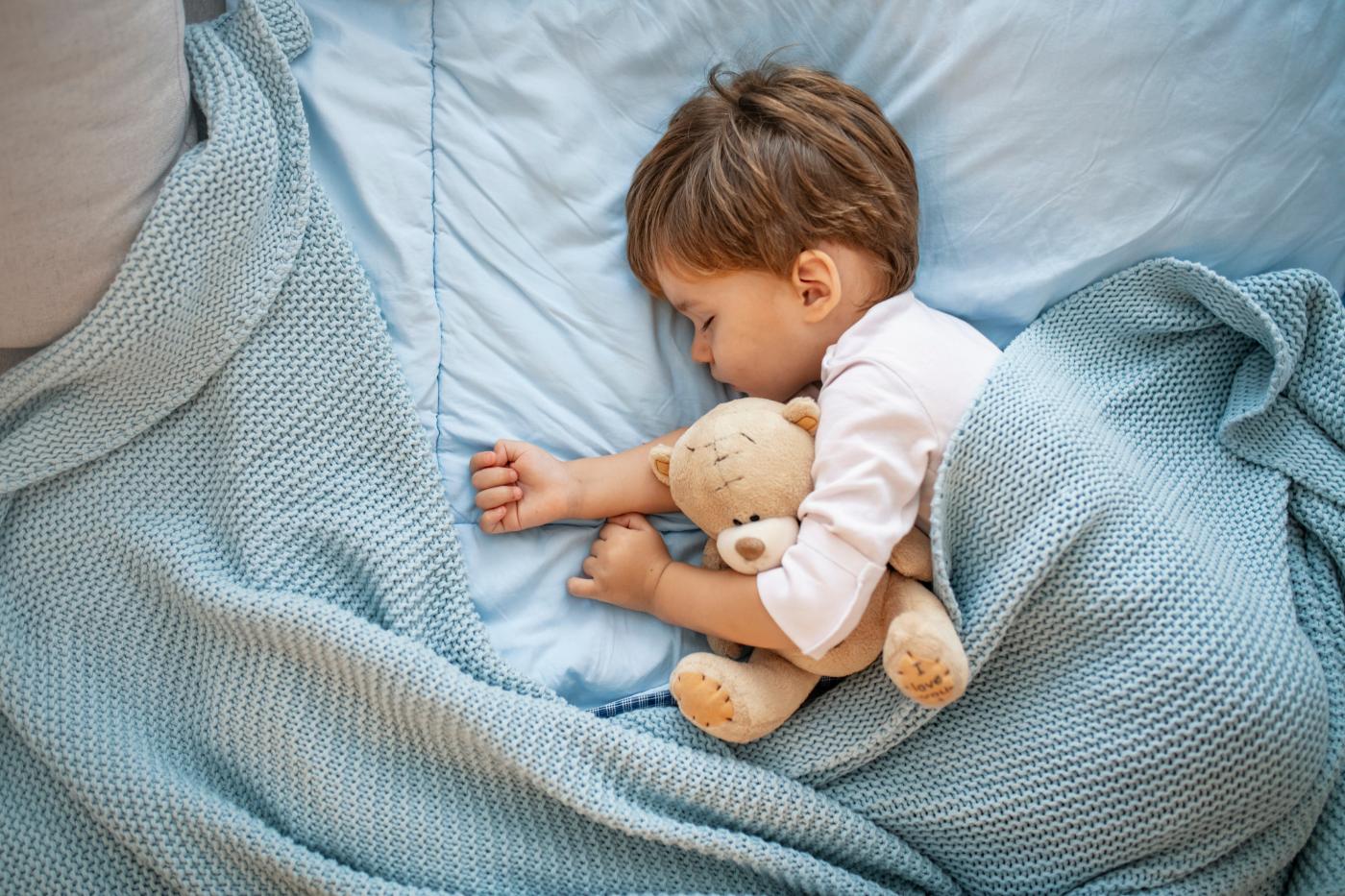Let's talk about sleep in childhood
According to the University of Navarra Clinic, sleep is a physiological state, in which there is a cessation of sensory activity, mobility and alertness. According to the digital library, Scielo, sleep is transcendental because in this period of time various maturation and development processes occur, including: the nervous system, growth hormone, memory consolidation, metabolic regulation and energy restoration. Next, we present everything about children's sleep.
PHASES OF SLEEP
Non-REM phase
National Institutes of Health (NIH) indicates that when the person begins to fall asleep, they begin with the non-REM Phase, which is divided into 4.
Phase 1: It happens when the person is between awake and asleep.
Phase 2: Deeper sleep begins, there is a disconnection from the environment and body temperature decreases slightly.
Phases 3 and 4: The deepest and most restorative sleep begins. At this time, blood pressure drops, breathing rate slows, muscles relax, the body repairs and grows tissues, energy is restored.
REM phase
The University of Navarra Clinic mentions that this stage is characterized by rapid eye movements, hence its name, rapid eye movement (REM). Additionally, an increase in metabolic activity and body temperature is observed. This process is essential for brain development, gene activity, and molecular repair. During this period dreams occur, because the brain is active. On the other hand, the National Institutes of Health (NIH) ensures that sleep cycles repeat, so the person will have this phase several times during the night.
HOURS OF SLEEP ACCORDING TO AGE
Babies up to 6 months: The National Sleep Foundation states that babies should sleep 14 to 17 hours during a 24-hour period. Even so, it is identified that there are newborns who sleep 18 to 19 hours a day. Additionally, Children's Minnesota states that newborns wake up only a few hours to eat, but if they sleep for long periods of time, they should be awakened every 3 to 4 hours to feed them, until their weight gain stabilizes, during the first two hours. weeks of life. Kids Health states that after this period babies can sleep up to 4 or 5 continuous hours.
On the other hand, it is recommended to establish sleep routines. Kids Health suggests that at night you can do: relaxing activities such as bathing the baby, reading a story or singing to the baby). Also, MedlinePlus advises exposing it to light and noise during the day. While at night the lights are turned off and the temperature is checked so that it is comfortable.
Babies between 7 to 11 months: Kids Health maintains that this season babies require 14 hours of sleep in a 24-hour period of time. If the baby wakes up at midnight and you consider that it is not hungry, you should wait a few minutes before going to see him, because sometimes babies only need a few minutes to calm down, after which they will recover sleep. However, if he cannot calm down and is not sick, it is preferable not to take him out of the crib or carry him in your arms. Instead, it is advisable to talk to him softly and touch his back.
On the other hand, MedlinePlus suggests that the baby's routine be constant and pleasant. Apart from that, the last food should be given before taking him to his crib. Additionally, before going to sleep you can rock him and hug him.
Children between 1 to 3 years: The WHO states that during this time the recommended hours are from 11 a.m. to 2 p.m., which will include two naps, with regular times for falling asleep and waking up. According to Kids Health, the routine can last between 5 to 30 minutes and can include listening to soft music. This habit should be simple and easy to apply so you can repeat it every night. Also, the child can be allowed to make some decisions such as: selecting his pajamas, choosing a stuffed animal or music. Likewise, you should limit the time you use electronic devices so that they do not affect your sleep during the night.
Children between 4 to 5 years: According to the Mayo Clinic, at this stage they should sleep between 10 to 13 hours at night, including naps. Kids Health mentions that when children have had enough sleep at night, the nap can be replaced with some downtime in the afternoon.
On the other hand, the American Academy of Pediatrics (AAP) states that sleep routines should be constant and that maintaining a continuous schedule allows you to regulate your biological clock and the quality of sleep. Additionally, it suggests avoiding the use of electronic devices at least an hour before bedtime. Also, it is recommended to reduce the intake of foods and drinks with caffeine or sugar before going to sleep.
Children between 6 to 12 years: Mayo Clinic reports that school-aged children require between 9 and 12 hours of sleep each night. During this season the little ones are already going to school, so they need to sleep well to have energy to learn and play. It is recommended that sleep schedules be maintained and that the sleeping space is adequate.
In summary, understanding the phases of sleep and maintaining sleep routines is essential for the proper development of the little ones. During each stage of life there will be differences in relation to sleep schedules, so they must be identified to ensure that your son or daughter is sleeping correctly, otherwise you can visit a specialist.
References:
How to sleep well: tips for parents of babies and toddlers. (2022). Patient education online. https://doi.org/10.1542/ppe_document258.spanish
Bedtime Habits for Babies and Children: MedlinePlus Medical Encyclopedia. (sf). https://medlineplus.gov/spanish/ency/article/002392.htm
National Geographic Spain. (2024b, January 22). National Geographic. https://www.nationalgeographicla.com/ciencia/2023/04/cuantas-horas-de-sueno-al-dia-son-ideales-para-cada-edad
Oropeza-Bahena, G., Sánchez, JDL, & Granados-Ramos, DE (2021). Sleep, memory and attention habits in school children. Mexican Journal of Neuroscience, 20(1). https://doi.org/10.24875/rmn.m19000021
What is REM sleep? (2018, September 7). https://espanol.nichd.nih.gov/. https://espanol.nichd.nih.gov/salud/temas/sleep/informacion/REM
What happens during sleep? (2018, September 7). https://espanol.nichd.nih.gov/. https://espanol.nichd.nih.gov/salud/temas/sleep/informacion/sucede
Dream during childhood. Care and advice. University of Navarra Clinic. (sf). https://www.cun.es. https://www.cun.es/chequeos-salud/infancia/sueno#:~:text=El%20sue%C3%B1o%20es%20un%20estado,organismo%20y%20regenerar%20energ%C3%ADas%20gastadas.
All about sleep. (2019, June). Kids Health. Retrieved January 22, 2024, from https://kidshealth.org/es/parents/sleep.html#:~:text=Los%20ni%C3%B1os%20de%20la%20etapa,y%20reposo%20por%20la%20tarde.
Villegas, E. (2023, January 30). How much should a child sleep according to his age? This is what the WHO says. HELLO. https://www.hola.com/padres/20230130342037/horas-sueno-ninos-segun-edad-oms/
World Health Organization: WHO. (2019, April 24). To grow up healthy, children need to spend less time sitting and play more. WHO. https://www.who.int/es/news/item/24-04-2019-to-grow-up-healthy-children-need-to-sit-less-and-play-more#:~:text=Deben%20tener%20de%2011%20a,regulares%20para%20dormirse%20y%20despertarse.













